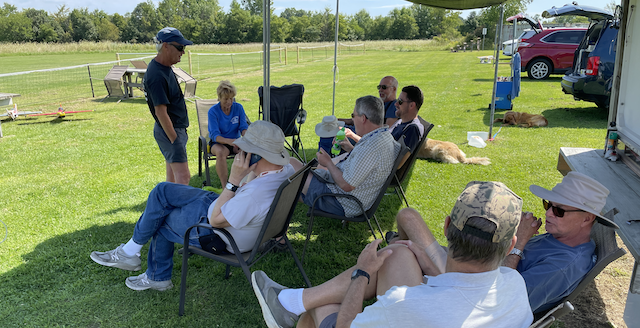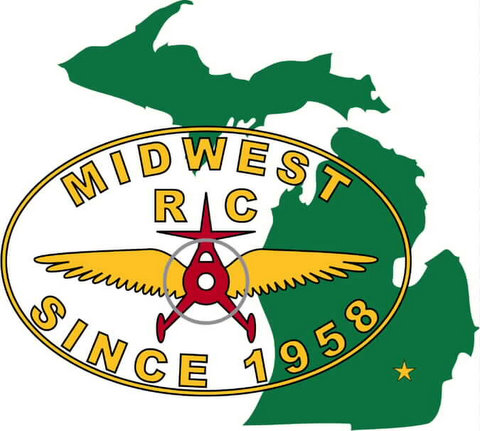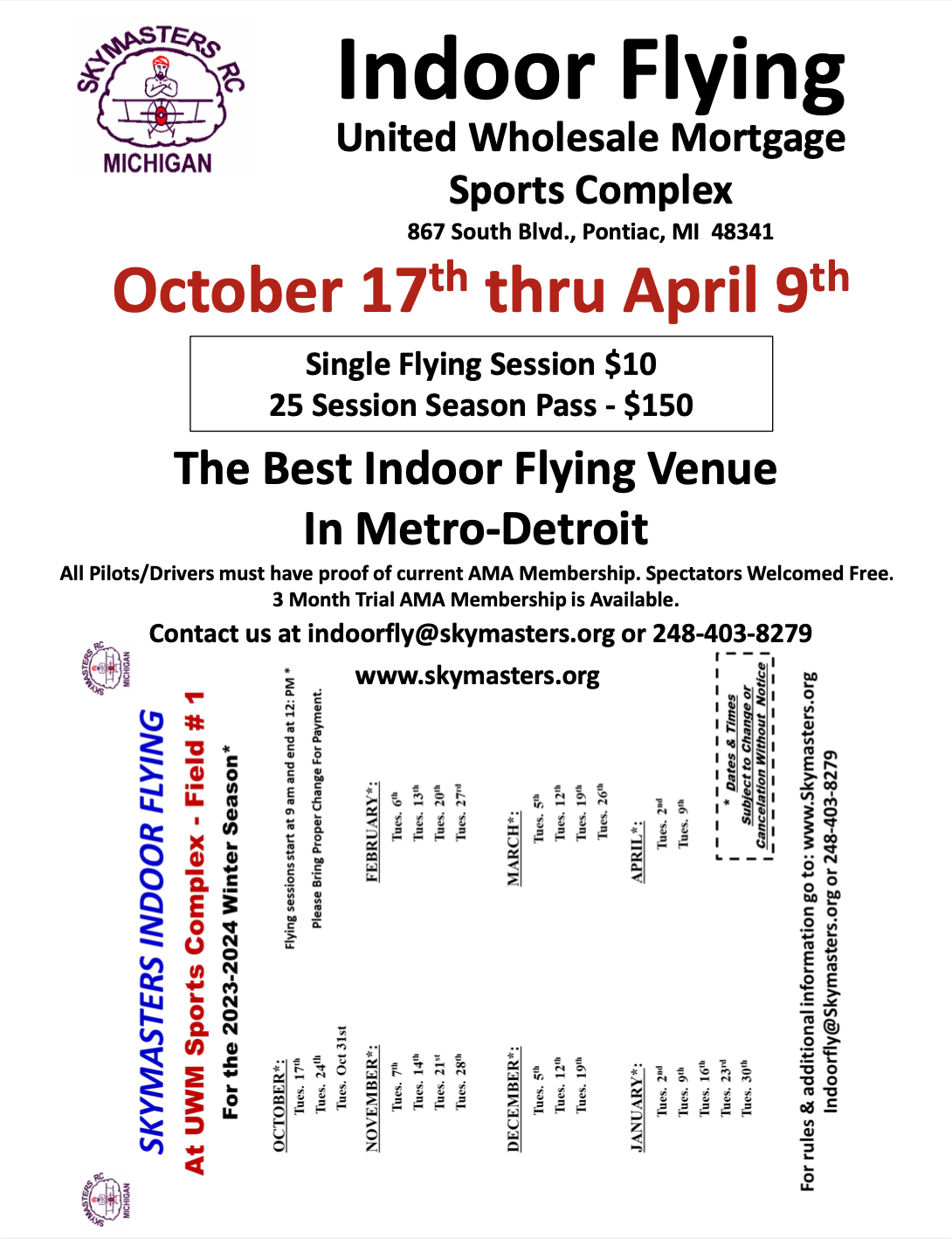 |
Flying High With Electric Power!
The Ampeer ON-LINE!
Fly the Future - Fly Electric! |
|---|
Site Table of Contents
| President: | Vice-President: | Secretary-Treasurer: |
| Ken Myers | Keith Shaw | Rick Sawicki |
| 1911 Bradshaw Ct. | 2756 Elmwood | 5089 Ledgewood Ct. W. |
| Commerce Twp., MI 48390 | Ann Arbor, MI 48104 | Commerce Twp., MI 48382 |
| (248) 669-8124 | (734) 973-6309 | (248) 685-7056 |
 | ||
| Board of Directors: | Board of Directors: | Ampeer Editor |
| David Stacer | Arthur Deane | Ken Myers |
| PO Box 75313 | 21690 Bedford Dr. | 1911 Bradshaw Ct. |
| Salem, MI 48175 | Northville, MI 48167 | Commerce Twp., MI 48390 |
| (313) 318-3288 | (248) 348-2058 | (248) 669-8124 |
| Upcoming EFO Flying Meeting: Saturday, Oct. 7, 2023 Time: 11 a.m.
Place: Midwest RC Society 7 Mile Rd. flying | ||
| EFO Flying Meeting Reminder Remember that the posted dates are tentative for the summer EFO flying meetings. | Are True Scale Props Possible? Scott McKie poses a question to Ampeer readers. |
| #11 Hobby Blades - Another Comment John Jackson shares his thoughts on these common knife blades. | Skymasters' Upcoming Indoor Flying Season Pete Foss announces the Skymasters' indoor flying season 2023/2024. |
| A FMS SuperEZ Aileron Servo Swap Ken shares a problem he had to overcome when doing an aileron servo replacement in his SuperEZ. | The September EFO Flying Meeting Photo and notes from the meeting. |
| A Tailgate Conversation Ken Myers shares a discussion he had with Keith Shaw regarding today's radio systems and foam ARFs. | More News From Innov8tive Designs Ken shares some more helpful info from Innov8tive Designs. |
| The Aurora from Aspect Laser Joe Hass shares a short review of this flying wing. | Electro-Star 600 Plans? Mike Tharp asks where he can get plans for this model. |
| Thoughts on Retiring a LiPo Battery Don Patterson asks when to know when a LiPo battery should be retired and Ken responds. | Midwest R/C SWAP MEET Info for the upcoming swap meet in Northville, MI on Nov. 5. |
| Skymasters' Indoor Flying Season Flyer The flyer for the Skymasters' Indoor 2023/2024 flying season. | |
If you have photos from this year that you'd like to share, please email them to me or let me know where you've put them on the Internet. Ken
Please keep in mind that all summer monthly EFO flying meeting dates are tentative and quite fluid depending on the predicted weather. The meetings are usually on Saturdays, but may change to the following Sunday or even possibly a week or more later. Everyone is welcome and proof of AMA membership is required to fly. The next EFO monthly meeting is Sat., October 7 at 11 a.m. Are True Scale Props Possible?
Hi Ken, Great issue (Sept. 2023 KM) - great pics - and still envious as hell of you guys. I've got a suggestion for us "true scale nuts" that can't stand seeing a little "itty-bitty" diameter / 2 blade prop on a scale model - that flew with a 3 or 4 blade larger diameter prop in it (in real life). Now that the motor comparison chart has been done and is out (I believe he's referencing Innov8tive Designs motor comparison chart. KM) - how about someone sitting down, and get serious about finding out the proper Kv motor figure / rpm / scale speed / to drive a:
And are you a lucky guy. (He seems to be referencing Joe Hass here. KM) No way would my wife let me have a model hanging from a light in any room of the house. I get grief by just having my model of the F-4 (and the ship) I flew off of my "bird-farm" ship, the USS MIDWAY. Scott McKie #11 Hobby Blades - Another Comment
Hi Ken, Thanks for all your work that goes into the Ampeer. Regarding the thread on re-sharpening #11 blades, I use one of these, which is a Kershaw 2535 Ultra-Tek Blade Sharpener with 600-Grit Diamond Coated Oval Shaft. The reason I have and use one is I help my son with carving EVA Foam floor tiles to build COSPLAY costumes. This foam can dull the best blades in about 2-3 cuts. I also use this sharpener on break-away blades when cutting foam since I often have the blade extended. Now I am just in the habit of giving a blade 2-3 passes on the sharpener as it is faster than changing the blade. Thanks,
Skymasters' Upcoming Indoor Flying Season
Hey Indoor Pilots, I'm very happy to announce that we will be hosting indoor flying at UWM Sports Complex, in Pontiac, again this year! Tuesdays 9-noon just like last year. Please see attached for the complete schedule. First flying date is Tuesday October 17th, so start getting your indoor planes in order! Thanks,
Pete Foss
The flyer that Pete mentioned is at the end of this issue. KM A FMS SuperEZ Aileron Servo Swap
I purchased the FMS SuperEZ in February of 2016. It served as my primary student pilot trainer plane and my "windy day" fun flier since then. More on the ESC Problem in the FMS SuperEZ A Change in the Stock ESC for the FMS SuperEZ The FMS SuperEZ PNP AKA SupREZ Review: Part 2 The FMS SuperEZ PNP AKA SupREZ Review: Part 1 It worked well as a primary trainer and fun flier for many years. There was a problem early on in my ownership. In a flight surface, preflight, radio check, the FMS servo. controlling the elevator, was totally unresponsive. After that electric fly, at the Skymasters' flying field, the defective servo was easily replaced with an EMAX servo of the same size. I had flown the SuperEZ through the spring and early summer of 2023. There were no issues. While doing a preflight radio check, before flying at the Mid-Am, I heard a "click-click" and determined that the right wing panel aileron servo had a stripped gear. Rats! On August 31, 2023, I decided to replace the servo. I thought that it might be a 15 minute, or maybe a 20 minute job. I was wrong! I easily removed the FMS servo and immediately noted that it had a different servo arm on it than the left panel servo had. "Strange," I thought. 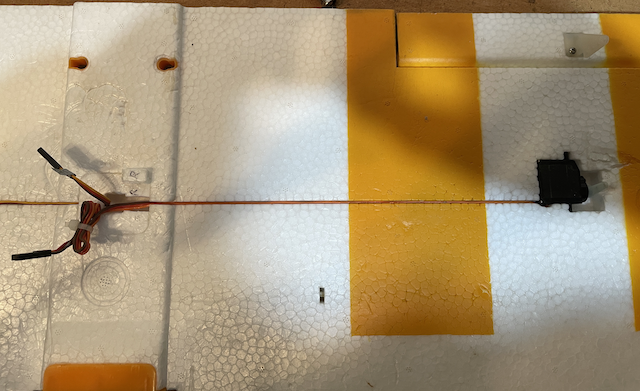 There were also the letters R and R on the foam near the connector exits. The letters can be seen in the photo. I hadn't put the letters R and R there. The lead on that servo was also a lot longer than the lead on the other servo and it had been wrapped to make it the same length as the other servo. "Strange," I thought. 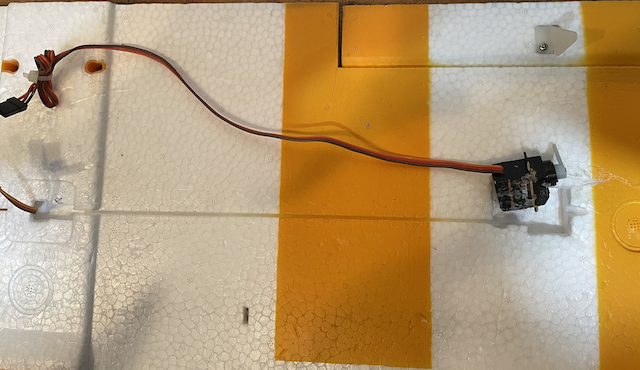 The bad servo was removed. 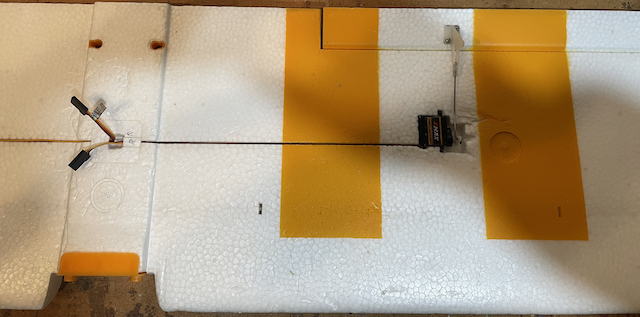 A new EMAX ES08MA servo was installed. I installed and glued in the EMAX servo. Next I tested it on the SuperEZ. I NOW HAD FLAPS!!! "Strange," I thought. The aileron connection is a "Y" harness type. I now had two options. I could change the wiring to the type where each servo is pugged into its own receiver channel and reverse the offending new servo. Easy enough, but I didn't feel like getting into programming. I opted to slightly modify the servo cutout, flip the servo and move the control horn. The new servo lead then required a short extension. 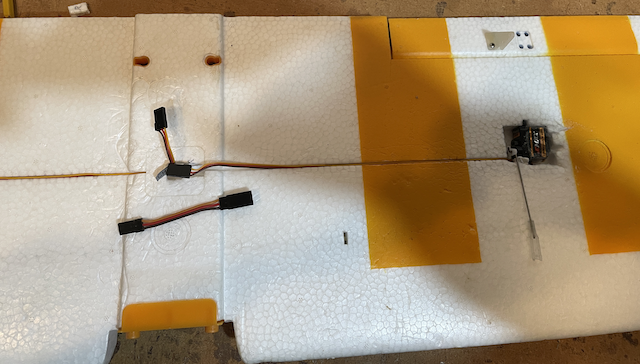 I did try this set up before gluing and taping in the new servo, and I now had ailerons, not flaps. 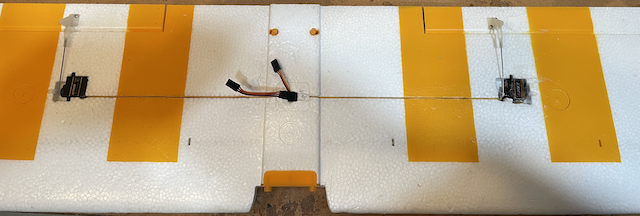 With everything working properly after a couple of hours of work, I filled the holes, left by the control horn move, in the ailerons, top and bottom with Lite spackle. I left the bottom, with just the white spackle showing but used a dark blue marker to color the spackle on the top of the aileron. The plane was flown at the September 2nd EFO Flying Meeting. Everything went well, although trying to get it truly re-trimmed was not possible because of the strong crosswind. It felt good to have this "old friend" flying once again. The September EFO Flying Meeting The EFO monthly flying meeting was held on Saturday, September 2, 2023. The meeting was very well attended on this beautiful day. The day started off with a bit of a chill, but quickly warmed up to a pleasant and comfortable temperature in the mid-70s, while later rising to just over 80 when the meeting broke up about 1:30ish. 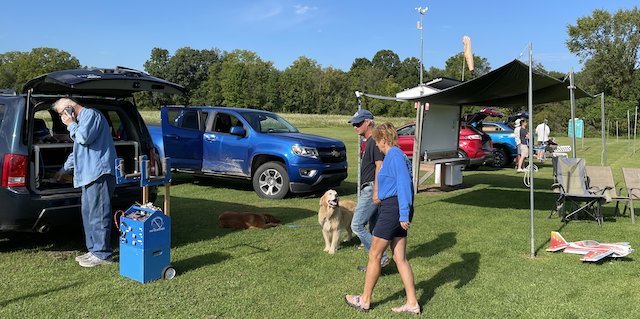
Pete, Carolynn and their dogs, along with Roger Wilfong get ready for a great day. Unfortunately, the winds were strong, gusty and from the southwest, which provided a direct cross-wind. 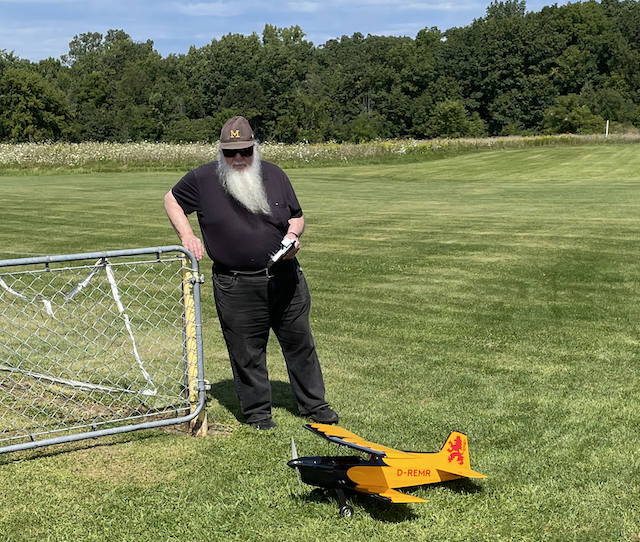
Note the wind blowing Keith's beard blowing after landing his Dreamer bipe.
That did not deter us from having a great day at the flying field. 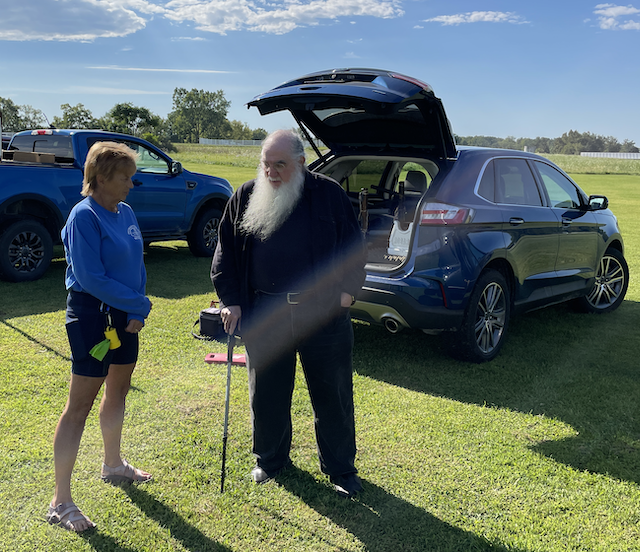 It was great to have Keith Shaw back and flying after his knee surgery. Many of us spent a lot of time catching up with Keith and finding out how his recovery is going. 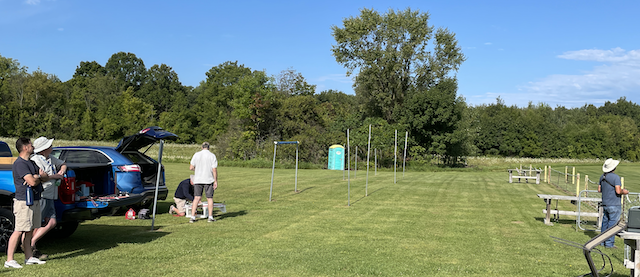
Lynn Morgan, at the far right, practicing pattern in the wind. Way to go Lynn! Well done. Everyone had a great time chatting and catching up. There were several flights that did take place and Lynn Morgan flew the most flights that day practicing pattern in the wind. 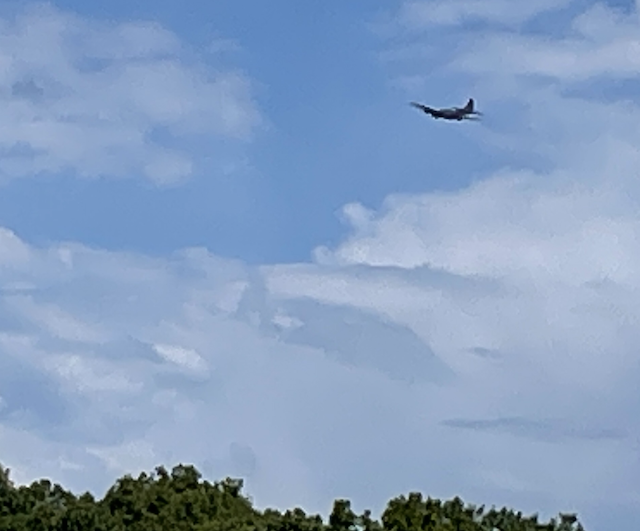 We had an interesting visitor, as the local B-17 flew low and slow by the field. Unfortunately, it took a bit of time to get the phone out of my pocket and snap the photo as it was flying away. It belongs to the Yankee Air Museum at Willow Run Airport, which isn't too far away from the flying field. It was a great day for rides in that plane!!! Beautiful! Pete Foss looks on as Keith takes his first flight since his surgery. A really great time was had by all attending. A Tailgate Conversation
Because of his surgery, Keith and I had not really had a chance to have a great conversation, at the flying field, about our great hobby. Shortly after he arrived, we finally got the chance, while sitting on his van's tailgate area. We started discussing the state of radio systems that are currently available. Keith told me about a YouTube video that he had recently watched regarding the range, and more importantly, how long it took for the systems to reboot when the RF was lost. When I returned home, I looked up the video. It is titled "The Ultimate RC Airplane Radio Showdown!" by The Lighter Side Of RC. Our discussion was brought about when I mentioned that beginners, who go to hobby shops in this area today, are more often than not, directed to Spektrum systems. There is absolutely nothing wrong with that! Today, their systems work well and beginners can get help with their radio systems at flying field, as the majority of fliers there, in the USA, will have some version of a Spektrum system. If you want to take the time to check out the video, you can see how the ubiquitous Spektrum compares to other available brands. We also discussed why we are seeing less user created models and more and more molded foam ARFs. Today's foam ARFs are pretty well designed, fly well, look reasonably good and have the power system installed. Those are all pluses for the folks who are time strapped with work, family and life in general. I always learn a lot and get some great advice and lots to think about from Keith, and I value it so much. Thanks, buddy!!! More News From Innov8tive Designs Last month, in the September 2023 issue, there was a short article titled "News from Innov8tive Designs". That article noted Lucien Miller's Motor Cross Reference Chart makes it easy to find a matching replacement motor for your aircraft. The chart is available for viewing online or as a convenient, downloadable 2-page PDF document. The following is from a recent email from Lucien Miller. "Glow to Electric Guide - For those that are looking to do a glow conversion our Glow-to-Electric chart can be quite useful. This chart will show you the Motor, ESC, Battery and Prop combination that will replicate the same power as the glow engine you are replacing. Each component has a link to the product on our website so you can take a closer look or add it your cart." "This conversion guide will direct the user to the correct size Electric Motor, Speed Controller, Battery and Prop needed to emulate the performance of a 2-Stroke glow engine, when used in a Sport Flying type Model aircraft. This guide uses the recognized standard of 1 Cubic Inch of 2-Stroke glow engine power being equal to 2000 Watts of electric power. While there are many different power system combinations that will work, the ones shown in this guide will use props that are similar in size to their glow counterparts for prop clearance considerations." I did not find a 4-Stroke chart. If you are reading this, you most likely won't need this information, but some of your flying buddies, who are still flying glow power, just might find this information useful. Also, since we are no entering "swap shop" season, you just might find a great deal on an airframe you’ve always wanted, with a glow motor installed, and it could provide a quick and easy conversion for you without having to do the math. Again, if you need a power system recommendation for your model, Innov8tive Designs can help you find the ideal setup! Contact Them and Tell Them What You Are Flying Check them out soon. KM The Aurora from Aspect Laser From Joe Hass via email Some of the information about this model was updated, as I'd received the original email a bit ago, while John Hoover still had his hobby shop. KM Another new project. This is the Aurora designed and kitted by John Hoover of Aspect Laser. 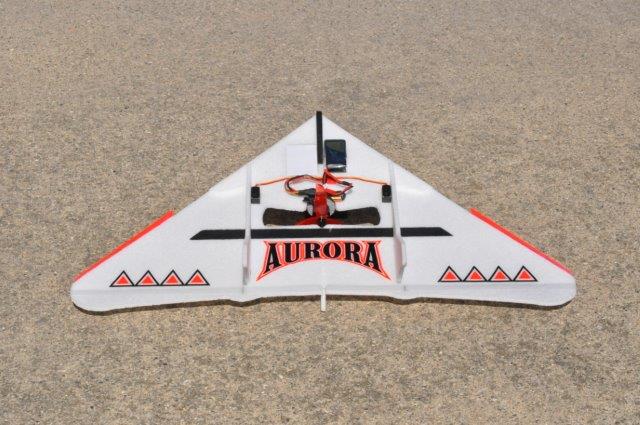 Joe added graphics to his model. 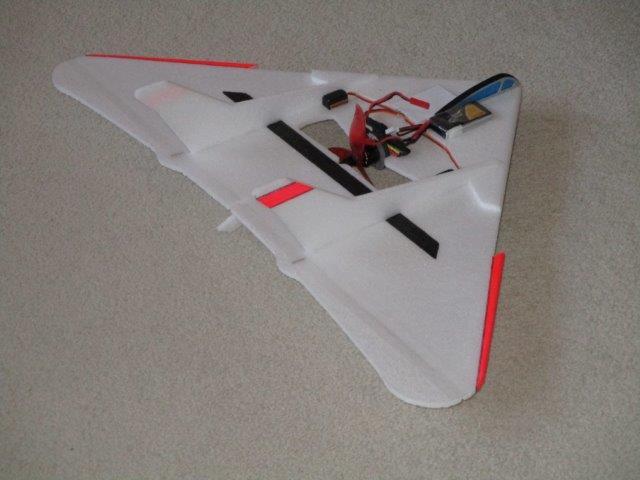 It has a 25" span and is made of Model Plane Foam and plywood. The kit is very complete with carbon fiber, pushrods, control horns and hinge tape. John offers packages for power, servos and or RC gear. It goes together quickly. While it can easily fly indoors, it is really at home outside where you can really burn up the sky at full throttle. It is very maneuverable yet very stable. It uses elevon mixing and throttle and a 3S 650mAh LiPo battery. Joe Hass
A Request for Some Help on an Old Electric Design
Ken, A long time ago (in a sane galaxy) there was a plan listed on the EFO site with a free plans download link. I lost my digital copy and was wondering if you or anyone you knew may have the files yet. If not it isn't a problem, again, a LONG time ago. Thank you.
R/C Electric Powered Interactive Update From: Robert Riggle Jr.
I now have kits and plans of my latest creation I call the Electro-Star 600. This is a redesign of the Electro-Star 15. After a lot of thinking of new ways of lightning this plane up, I was able to cut 8 oz from the original weight of 72 oz. 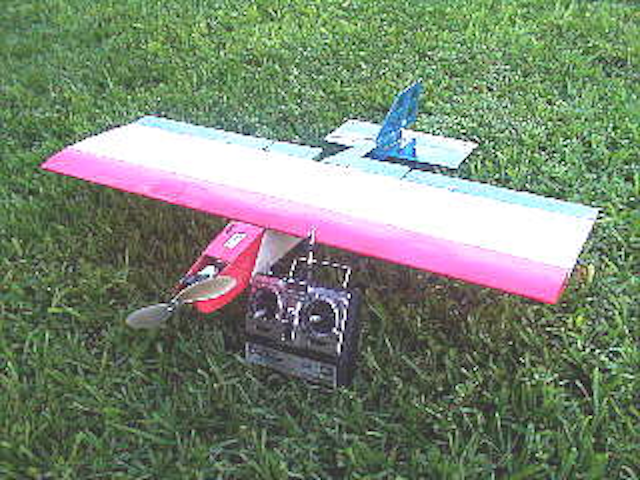
Electro-Star 600 Specs: Wing Span: 62 in.
You can buy the Electro-Star kit or plans on my Online Store Members can download the plans free Robert Riggle Jr
If anyone has info that would help Mike, please let me know. It was interesting to see where we were just a few short decades ago. ;-) KM Thoughts on Retiring a LiPo Battery
Hi Ken, I now have a Giles MK II ESR meter and it works great. I have also read a lot in the links you sent me. They sure helped. I was wondering if there is a level of ESR that suggests retiring the subject pack. I checked a 3S 2250 pack and got C=18, Max current 40 amps, and ESR in the mid twenties. I put this pack in a Maule M7 model and my watt meter showed 10.95 volts, 436 watts, and 40 amps at WOT. This pack was used to set up the radio but was close to fully charged. I think it was five or six years old. I shut down immediately after getting the data because in the past I smoked a motor with excessive ground running. The motor can was never more than warm but it must have been much hotter inside. Thanks and take care,
Hi Don, What we commonly call the battery's IR, a value that is assigned to a battery's internal resistance measured by various devices, is a variable number, not an absolute number. It varies by the device being used to provide the value, the temperature of the battery and the state of charge of the battery (SOC). A few years ago, when I was testing a lot of different devices that supplied IR values, including the Giles ESR meter, Revo Honesty meter and the Vollrath BattIR meter, I also found differences in the provided IR values depending on how stable the voltage was in the pack when the measurements were taken. Once a battery has been charged, it takes hours to reach a voltage stabilized state, as measured by a voltmeter. The stabilized voltage can be quite different from the voltage at the termination of the charge, once the electrons have settled down from being "so excited". Once a battery has been discharged, even slightly by one of the measuring devices, it takes hours to reach a voltage stabilized state, as measured by a voltmeter. Throw in the battery's normal self-discharge, over time, and there are now even many more variables to contend with. You didn't note whether you took the IR value before your motor test or after. Either way, you’d get slightly different values. Here is what Wayne Giles recently said about the Lipotool part of the the meter that you are using on Sept. 08, 2020 on RC Groups. "The Lipotool will only work with lipos, not LiFePO4 cells. "Strictly it is based, largely empirically, on the measurements as taken by the ESR meter as we compared many real full discharge results with the Cell IR figure taken at 25*C to work out the heating calculation. This means that the predicted max safe continuous current would not over stress the cell, the criteria being excess temperature rise or sag and recovery of the cell voltage. John Julian and Mark Forsyth compared the results using some other chargers and the only ones that gave acceptable results were the FMA chargers and i - chargers. One gave slightly higher results and one lower; sorry but I can't recall which was which now. Many chargers give wildly differing results so we cannot vouch for their use in the Lipotool calculation. Wayne" Note that 25 degrees Celsius is noted in Wayne's statement. That is 77 degrees Fahrenheit. Somewhere in the instructions for at least one of the tools I was testing for comparison, I remember 22 degrees C, about 72 degrees F, being noted as the "best" temperature, and that was what I used for my comparative testing of the devices. If the same battery is tested at well above 22 degrees C, the value provided for the IR device will be lower than at 22 degrees C. If the same battery is tested at well below 22 degrees C, say 15 degrees C, or about 59 degrees Fahrenheit, the value provided by the IR device will be much higher than at 22 degrees C. To answer your question, "I was wondering if there is a level of ESR that suggests retiring the subject pack?" The simple answer is no. I have two 3S 2200mAh LiPo packs, of the same brand, that I've been using for the past three years in the same trainer-type plane. I don't believe that I ever checked their IR. They are used in a low amp draw situation. A pack is flown for two 8 minute training flights, using the timer on my transmitter, and usually not recharged at the flying field. The second pack is used in the same way. That provides 32 minutes of flight training on that trainer. I described how it is used to illustrate that the mission is always identical with the only variable, of consequence, being the wind on the day of the training flights, but because they are training flights, the wind cannot be very high for the student to fly the plane. After they are used, I put them in the LiPo Sack and measure the individual cell voltages after arriving home. After training I usually hang around the flying field for a bit and my drive home takes 35 to 40 minutes or so. This gives the packs a good time to reach a stabilized voltage. For the past 3 years both packs have always been at approximately 3.75V to 3.8V per cell, which is what I use for a storage charge. If I were to see about 3.6V per cell, and knew that all of the flight conditions had been pretty similar to all of the pervious flight conditions, I might want to start "keeping an eye" on that pack. Yes, this is an extreme example, but if the same type of mission is flown, for the same measured time, under pretty much the same wind conditions and ambient temperature, you can see when a pack starts fading. There really is no simple answer as to when to retire a pack. All I can advise is when you notice a drop in performance, from what you normally experience, and it cannot be accounted for by environmental conditions, you might want to retire the pack to a different application or just permanently retire it. To reiterate, does just seeing a higher IR value on a device, for the same pack over time, indicate that the pack should be retired, not really, but it could be an indicator, sort of, if all readings are done under as identical conditions as possible. Hope this helps,
Midwest R/C SWAP MEET Sunday, November 5th, 2023 8:15AM to 12:00PM Location
Admission Charge
Vendor Table Cost
For information and table reservations
Directions
LARGEST and BEST swap meet in SE Michigan! Return to "What's In This Issue"
To Reach Ken Myers, you can land mail to the address at the top of the page. My E-mail address is: KMyersEFO@theampeer.org |
